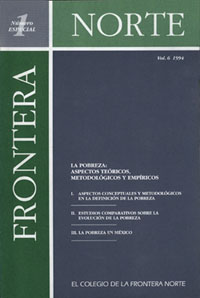A Poverty Profile of Mexico in 1989
Contenido principal del artículo
Resumen
Detalles del artículo
Las/los autoras/es que publiquen en esta revista aceptan las siguientes condiciones:
- Las/los autoras/es conservan los derechos de autor y ceden a la revista Frontera Norte (RFN) el derecho de la primera publicación, mediante el registro de los textos con la licencia de Creative Commons Atribución-No comercial-Sin derivar 4.0 internacional (CC BY-NC-ND 4.0), que permite a terceros utilizar lo publicado siempre que mencionen la autoría del trabajo y a la primera publicación en esta revista.
- Autorizan que su artículo y todos los materiales incluidos en él sean reproducidos, publicados, traducidos, comunicados y transmitidos públicamente en cualquier forma o medio; así como efectuar su distribución al público en el número de ejemplares que se requieran y su comunicación pública, en cada una de sus modalidades, incluida su puesta a disposición del público a través de medios electrónicos o de cualquier otra tecnología, para fines exclusivamente científicos, culturales, de difusión y sin fines comerciales.
- Los autores/as pueden realizar otros acuerdos contractuales independientes y adicionales para la distribución no exclusiva de la versión del artículo publicado en esta revista (por ejemplo: incluirlo en un repositorio institucional, página web personal; o bien publicarlo en un libro) siempre que sea sin fines comerciales e indiquen claramente que el trabajo se publicó por primera vez en Frontera Norte (RFN), [agregando la ficha bibliográfica correspondiente: Autor/es. (año). Título del artículo. Frontera Norte, volumen (número), pp. doi: xxxx ].
Para ello, los autores deben remitir el formato de carta-cesión de la propiedad de los derechos de la primera publicación debidamente llenado y firmado. Este documento debe cargarse en formato PDF en archivos complementarios dentro de la plataforma OJS.

Este obra está bajo una licencia de Creative Commons Atribución-No comercial-Sin derivar 4.0 internacional (CC BY-NC-ND 4.0).
Citas
See Santiago Levy, Poverty Alleviation in Mexico, Working Paper Series, no. 679 (Washington, D.C.: The World Bank, 1991).
For further details, see Diana Alarcón, "Changes in the Distribution of Income in Mexico during the Period of Trade Liberalization," Ph.D. dissertation, University of California, Riverside, December 1993.
Levy also made estimates of poverty based on constructing a line of moderate poverty. The construction of the consumption basket used to define moderate poverty was based on the pattern of consumption of the seventh decile, but it includes several other consumption goods considered essential components of a minimum standard of living. Not surprisingly, over 70 percent of the population have usually been classified as poor when such a methodology is used. The methodology used to construct the consumption basket for moderate poverty can be found in: COPLAMAR, Macroeconomía de las necesidades esenciales en Mexico: situación actual y perspectivas al año 2000, 2d. ed. (Mexico: Siglo XXI, 1989): Appendix II.
All of the above percentages are based on the whole sample of 11 525 households, which are weighted in order to represent the underlying population. Our results based on weighted data usually differ only marginally from those based on unweighted data, which we used initially in order to compare our results to those of the Levy study.
In much of the analysis in this section and others, we analyze the characteristics of the head of household. As is well known, this is not a completely reliable indicator of the condition of the whole household. We hope in the future to supplement our current findings with an analysis of all household members.
All expenditure and income statistics for 1989 are reported in old pesos. In order to convert to new pesos, divide all figures by 1000.
Regression analysis bears out this relationship between the age of the household head and per capita household income for the Mexican population as a whole.
For an elucidation of this methodology, see Lionel Demery, "The Poverty Profile," in Understanding the Social effects of Policy Reform, ed. Lionel Demery, Marco Ferroni, and Christiaan Grootaert (Washington, D.C.: The World Bank, 1993).
For an early application of this concept, see Sudhir Anand, Inequality and Poverty in Malaysia (Washington, D.C.: Oxford University Press, for the World Bank, 1983).
This percentage is equal to 1 minus the income gap ratio.
See Martin Ravallion, Poverty Comparisons: A Guide to Concepts and Methods, Living Standards Measurement Study, Working Paper No. 88 (Washington, D.C.: The World Bank, 1992).
The 1989 Income-Expenditure Survey does not strictly differentiate between rural and urban areas; it differentiates between what it calls "high-density areas" and "low-density areas." For an explanation of this distinction, see INEGI, Encuesta Nacional de Ingreso-Gasto de los Hogares 1989 (México; INEGI, 1992).
For an illustration of the use of this methodology, see a recent publication: Azizur Rahman Khan, Keith Griffin, Carl Riskin, and Zhao Renwei, "Household Income and Its Distribution in China," in The Distribution of Income in China, ed. Keith Griffin and Zhao Renwei (New York: St. Martin's Press, 1993).
Income from cooperatives is the component most prevalent among the poorest of the poor, with a negative concentration ratio, but it is an insignificant proportion of the poor's total income.
